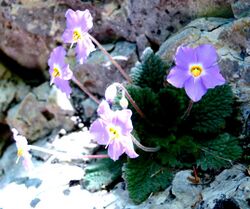Biology:Ramonda myconi
| Ramonda myconi | |
|---|---|

| |
| Scientific classification | |
| Kingdom: | Plantae |
| Clade: | Tracheophytes |
| Clade: | Angiosperms |
| Clade: | Eudicots |
| Clade: | Asterids |
| Order: | Lamiales |
| Family: | Gesneriaceae |
| Genus: | Ramonda |
| Species: | R. myconi
|
| Binomial name | |
| Ramonda myconi | |
| Synonyms[1] | |
| |
Ramonda myconi, the Pyrenean-violet[2] or rosette mullein, syn. R. pyrenaica, is a species of flowering plant in the family Gesneriaceae, which is a relictual endemite of shady, rocky places in the Pyrenees and north eastern Spain. It is a rosette-forming evergreen perennial growing to 10 cm (4 in) high by 20 cm (8 in) broad, with oval, crinkled leaves. Five-petalled purple flowers with prominent yellow anthers appear on leafless stems in spring.[3][4]
The plant is cultivated, for instance in vertical crevices where its roots are not subject to winter wetness. It has gained the Royal Horticultural Society's Award of Garden Merit.[5][6]
The Ramonda myconi are a Mediterranean endemic species, meaning that the species is native to that geographic region. This species of flowering plant is isolated to the rocky terrains that border France and Spain. This species also belongs to a group known as resurrection plants.[7] This means they can survive or tolerate severe desiccation or drought.
References
- ↑ The Plant List: A Working List of All Plant Species, http://www.theplantlist.org/tpl1.1/record/kew-2605321, retrieved 3 October 2015
- ↑ (xls) BSBI List 2007, Botanical Society of Britain and Ireland, https://bsbi.org/download/3542/, retrieved 2014-10-17
- ↑ RHS A-Z encyclopedia of garden plants. United Kingdom: Dorling Kindersley. 2008. pp. 1136. ISBN 978-1405332965.
- ↑ "NARGS Wiki - Plant of the month June 2009 Ramonda myconi". http://nargs.org/nargswiki/tiki-index.php?page=Plant+of+the+Month+June+2009.
- ↑ "RHS Plant Selector - Ramonda myconi". https://www.rhs.org.uk/Plants/14323/Ramonda-myconi/Details.
- ↑ "AGM Plants - Ornamental". Royal Horticultural Society. July 2017. p. 84. https://www.rhs.org.uk/plants/pdfs/agm-lists/agm-ornamentals.pdf.
- ↑ Dubreuil, Marta (1 May 2008). "Genetic structure and diversity in Ramonda myconi(Gesneriaceae): Effects of historical climate change on a preglacial relict species". American Journal of Botany 95 (5): 10,577–587. doi:10.3732/ajb.2007320. PMID 21632384. https://doi.org/10.3732/ajb.2007320. Retrieved 28 October 2021.
External links
Wikidata ☰ Q1308287 entry
 |



